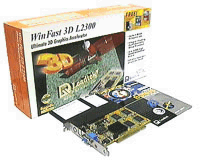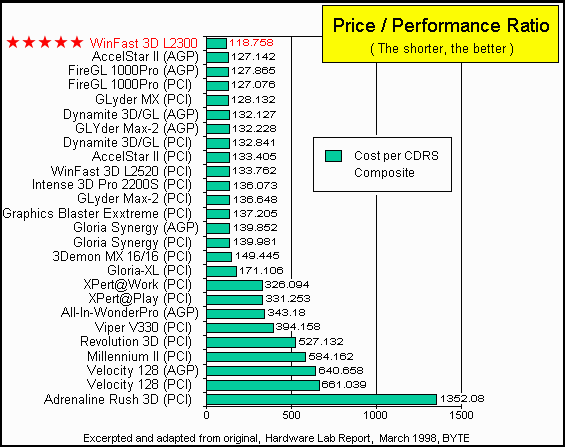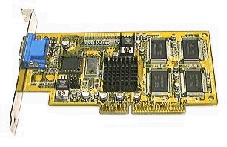 Leadtek Research's WinFast
3D L2300
Leadtek Research's WinFast
3D L2300 Leadtek Research's WinFast
3D L2300
Leadtek Research's WinFast
3D L2300
†
On the 19th of September 1997, Leadtek Research Inc. (a world wide leading engineering company designing and manufacturing high-end 3D graphics accelerators for x86 based systems and DEC Alpha workstations) announced the arrival of the WinFast 3D L2300 graphics accelerator (based on the 3D Labs Permedia 2 graphics processor) boasting entry-level professional 3D graphics performance for real-time based 3D applications together with unbeatable 2D performance for office applications (available in both AGP and PCI interfaces).
"The Winfast 3D L2300 gets double honours for Best Overall and Best ValueÖ The 8 M-byte WinFast 3D L2300 outperformed every other board in its class and came within a whisker of high-end boards costing over ten times as muchÖ"
BYTE magazine, March '98
The WinFast 3D got a very impressive write-up in the Hardware Lab Report of BYTE, but what makes this card so good?
All OpenGL rendering operations under Windows 95 or Windows NT are accelerated through this card. This includes techniques such as Gouraud shading, flat shading, high accuracy per pixel fog, Alpha blending, interpolated specular / diffuse lighting, bilinear filtering, per pixel mip-mapping, 16-bit Z buffering, and a lot more.
†

Features
2D / 3D Performance Figures
Software Compatibility

System Requirements
Supported Resolutions
Up to 200 Hz refresh rates and true colour, flicker-free display.
|
|
|
|
|
|
|
|
|
|
|
|
| ÷ | ÷ | |||
| ÷ | ÷ | |||
| ÷ | ÷ | |||
| ÷ | ÷ | |||
| ÷ | ÷ | |||
| ÷ | ÷ | |||
| ÷ | ÷ | |||
| ÷ | ÷ | |||
| ÷ | N/A | |||
| ÷ | ÷ | |||
| ÷ | ÷ | |||
| ÷ | N/A | |||
| ÷ | N/A | |||
S- single buffer. D- double buffer. 3D hardware acceleration is not functional at 256 colour mode.
*- Windows 95 only. **- WindowsNT only.
Bundled Software
Supported API's (Application Programming Interfaces)
According to WHAT PC? (April '98 issue):
"A well designed product should be compatible with both Direct3D and OpenGL."
Direct3D has been designed by Microsoft to provide programmers and hardware designers with what has been recognised as an industry standard to use 3D graphics under Windows. OpenGL is also set to become popular as a Windows 3D standard with Quake, Quake II and Hexen supporting it. The WinFast 3D L2300 pays equal attention to both environments (via a fully Installable Client Driver for OpenGL). The ICD comprehensively follows graphics functions under the OpenGL standard and fully utilises hardware to implement these functions. In other words, you can enjoy speedy real-time based 3D display in a broad range of high-end 3D applications. A definite advantage!
The ICD is integrated into the GDI display driver and accessed via a hook-out mechanism. It encompasses an entire OpenGL pipeline allowing vendors to accelerate all parts of the OpenGL pipeline and expose extensions freely. This offers all the flexibility and performance potential of a custom OpenGL DLL, but with better compatibility with existing software and significantly easier bring-up. However, implementing an ICD forces a vendor to have a GDI driver already in place. This may not be feasible for some vendors.
Conclusion
This board has been positioned as a general-purpose board for almost all segments of the market with an impressive set of features. It achieves good graphics performance on a wide range of platforms thanks to the Permedia 2 chipset and a comprehensive and balanced architecture. Consequently, the user of the WinFast 3D L2300 can expect to see a significant performance increase in many 3D based and video playback areas.
"The combination of Permedia 2's 2D and 3D performance and Leadtek's engineering expertise and manufacturing capability has produced a board that delivers industry leading performance and value for money."
Neil Trevett, Vice President of Marketing, 3D Labs